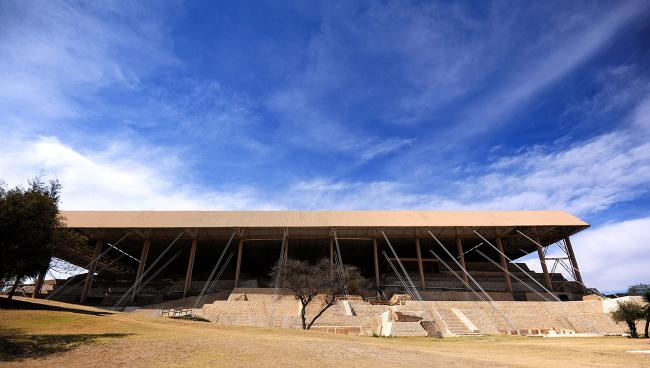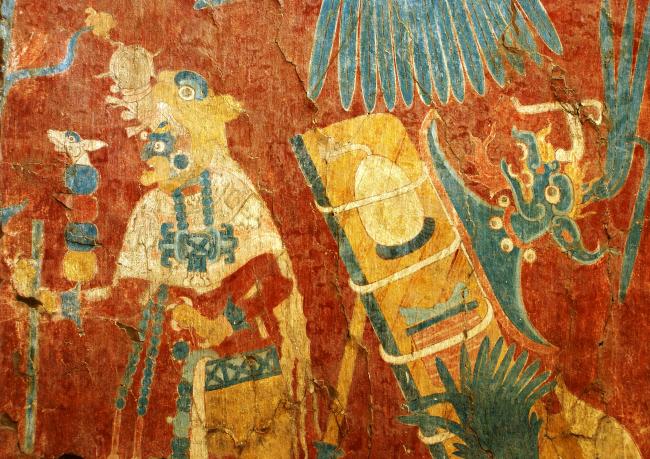
Cacaxtla: Gran Basamento
It is a natural elevation adapted as a platform of staggered bodies with sloping walls. It is characterized by holding living areas and open spaces, some in the form of sunken courtyards delimited by walls superimposed on slope, and built with materials such as tepetate and adobe covered with stucco, which were richly decorated with impressive mural paintings.
Temple of Venus: It is called this way by the repeated appearance of the snail cut transversely, representation of the stellar eye related to Venus. On the east side of the pillars of this building there are two characters, both with their bodies painted in blue and wearing similar attire, although one of them has a scorpion tail as an additional adornment.
Red Temple: It contains two murals. Unlike the other paintings in Cacaxtla, the human figure is secondary, since those of vegetables and animals predominate. It also represents an old man with jaguar attire and attributes of the rain god, accompanied by his calendrical name (Four Dog).
Lattice: It is a unique architectural element of its kind in Mesoamerica. It was built with a structure of branches covered with mud to give it shape, to which a lime and sand coating was applied.
The Palace, Patio of the Rhombuses and Patio of the Altars: It corresponds to the last stage of occupation of the place, it is conformed of a complex of enclosures that were continuously modified and adapted for diverse uses, mainly that of privileged rooms.
On the floors of this complex and in other areas, the remains of 200 children sacrificed at the time of initiating a new constructive stage were located.
Among the outstanding elements of this structure are the Patio de los Rombos, so called because of the elements in relief that adorn its walls, and the Patio de los Altares, so called because of the existence of two altars in its center.
Mural of the Battle: This element was made between the year 650 and 700, because of its pictorial theme it has been related to Mayan painting of the same period. It represents the confrontation between two morphologically distinctive groups; a group of “defeated” who wear bird headdresses, rich plumage and jade jewelry, they are evidently wounded and mutilated. And another group of “victors” who have mostly attires with jaguar skins and are represented in full action against the first group with spears, obsidian knives and spear throwers.
South Jamba: It shows a character framed by a band with representations of aquatic animals, covered with the skin of a jaguar, holding between his arms a bundle of spears from which water drops flow. He is standing on a reptile with feline attributes. In the lower left corner there is the numeral “nine eye of reptile” in flames, related to Quetzalcóatl in his invocation to Ehécatl, god of the wind. Superimposed to this mural is a clay relief that represents a seated personage, who has been related to Cocijo, Zapotec god of corn, for his elaborated headdress with remains of the image of a bat.
Building E: This one shows a personage framed by a band of aquatic animals, dressed with bird-like elements in his headdress, shoulders and arms, as well as claws on his feet. He holds a serpent bar between his arms, characteristic for the same period in the central Maya area. The personage is standing on a feathered serpent, bearded, carrying two elongated nostrils and next to them a scroll. To the left is a macaw. Below is a numeral: a bar and dots with a feather.
Portico. Building A: It shows a richly attired personage, whose hair, knotted and stopped with a bun and a diadem on the top of the head, falls down the back. It has locks strung with tubular beads and yellow flowers at the ends. The figure holds a sea shell from which a small human figure emerges. Two numerals are observed: in the upper part the “Three deer”, and in the lower part the “Seven reptile eye”.



